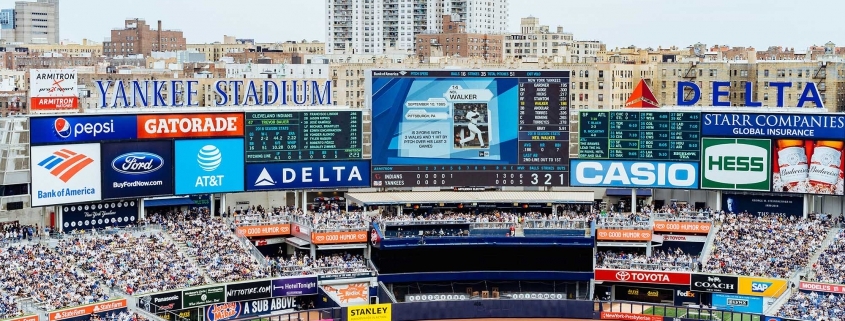Get in the Community Game: 13 Key Components You Need, Part 3
We’re continuing our highlights of the 13 key components to creating a great community to recruit, nurture and convert your customers – all with a game day twist. Today, we’re wrapping it up with the last 4:
11. Concessions
One of the best parts of the game: the delicious concessions served. And once you finally get to the front of the line, who can resist ordering the biggest drink or extra toppings on your hot dog? Concession stands are big money-makers and the sales team leverages all chances to tack on an extra sale or an up-sell. You should, too! Identify smart and natural opportunities within your community experience to convert, cross-sell and up-sell your members.
While stadium concessions might be a little “in-your-face,” figure out if this is the right strategy for you or tweak to best fit your brand. Should you take the passive approach of a static concession stand, or actively approach leads with opportunities like the wandering concession attendants? This will be determined by your sales cycle and the relevance of your community features to your brand products. Great places to convert are:
- Registration: During the original registration process, members are already filling out information and checking boxes. If you communicate a strong value proposition, you can position your products or services as a community add-on.
- Sticky Content: Members are attentive when engaging with the features they like most. Use that opportunity to education about relevant products and services.
- Content: Strategically place relevant brand information within articles and videos, creating a very soft-sell approach and creating demand and interest.
- Halftime Show: You aren’t going to get or keep everyone interested in the game, and that’s okay – there’s always the halftime show, intermission, or the 7th inning stretch to entertain the audience and keep/regain their attention. This is where your re-engagement campaigns come in. Use retargeting ads and your member email program to engage with current community members and introduce them to great new features and content.
Just one bad experience can cause a user to never come back, but you shouldn’t give up on them! Create a re-engagement email flow targeting inactive users and probing them with recommended content. That didn’t work? Use that opportunity to ask what you can improve from those that know best with a survey. Put effort into regaining your old members before you spend time, money and energy replacing them with new ones.
12. Post-Game Player Meet & Greet
Fans will wait hours for the chance to meet the big names behind the magic. Players are coveted components with limited accessibility and a talent unparalleled by the masses. Duplicate this exclusivity by featuring opportunities for members to converse with representatives from your own company or those related to your product and provide access to the faces behind your brand. These will be seen as valuable, one-time-only opportunities, so make sure to use them wisely. Capitalize on the audience’s attention with tasteful high-priority brand messages, and collect any components of the experience that can be repurposed for future content. Some examples of these opportunities include:
- Live Chats
- Q&A Sessions
- Advice Mailbox Submissions
- Live Videocasts
Foster hype around these events with focused campaigns and website countdowns. You could also use these opportunities to surprise-and-delight your members with real-time surprises – digitally or even offline.
13. Scoreboard
In sports, everyone needs a constant tally to keep them in the loop. Not just the big game score, but the number of yards, strikes, fouls, saves and anything else the scoreboard is willing to feature. Make sure your internal scoreboard is fully stocked: determine your success metrics, establish accurate and timely reporting infrastructures and measure against your goals. You can even share your successes and accomplishments with your community so they can take part in your triumphs. Keeping an accurate and timely reporting structure enables you to learn the following:
- WHO is most likely to engage with your brand and WHAT are the features and interests that will most likely draw interest and attention for your brand?
- WHO should you be targeting that will continue to engage most with your brand and WHAT features and interests will help to maintain interest and affinity?
- WHO should you be targeting that is most likely to convert and will provide you with the largest lifetime value and WHAT features and interests do they have?
- HOW should you be segmenting and targeting your prospects and customers to achieve the best awareness, engagement and conversion?
A community without a good stats team is at a supreme disadvantage. This is how you learn what’s working and what’s not working – giving you the insights to change and optimize across your recruitment, engagement and conversion efforts. Remember, it’s not whether you win or lose (or is it?)…but it is important that someone somewhere keeps the stats – how else would the players know where they need to focus their efforts to improve?
Whew. 13 key components? I’m winded. Let’s recap what you need for a game-day success.:
- Innovative Marketing Plan
- Offer or Gift
- Gating Strategy
- Friendly Website Flow
- Conversation
- Content
- Sticky Content
- Dynamic Content
- User Recognition
- Conversion Opportunities
- Re-Engagement Efforts
- Exclusive Experience
- Strong and Comprehensive Analytics
Create the 13 components above and you’re on your way to building your own community experience to generate and nurture leads, and ultimately increase revenue. Now, let’s get to work…as soon as I’m done my crackerjacks.





